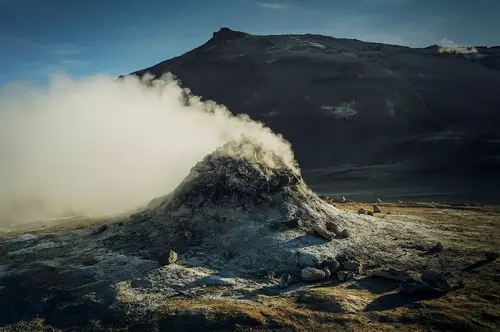1% of global electricity is generated from Geothermal
0.54 % Share of global electricity
38 gCO2eq/kWh Carbon Intensity

| Country/Region | kWh/person | % | TWh |
|---|---|---|---|
| Iceland | 13259.6 W | 28.2% | 5.3 TWh |
| New Zealand | 1817.1 W | 22.2% | 9.6 TWh |
| Nevada | 1168.3 W | 8.1% | 3.8 TWh |
| Costa Rica | 292.2 W | 11.8% | 1.5 TWh |
| California | 275.3 W | 3.6% | 10.8 TWh |
| Guadeloupe | 260.0 W | 6.1% | 0.1 TWh |
| El Salvador | 232.4 W | 17.7% | 1.5 TWh |
| Hawaii | 175.2 W | 2.2% | 0.3 TWh |
| Utah | 128.9 W | 1.2% | 0.5 TWh |
| Nicaragua | 101.1 W | 12.5% | 0.7 TWh |
| Kenya | 98.5 W | 39.5% | 5.5 TWh |
| Turkey | 98.5 W | 2.5% | 8.7 TWh |
| Philippines | 86.2 W | 8.3% | 10.0 TWh |
| Indonesia | 60.2 W | 4.8% | 16.9 TWh |
| Italy | 57.6 W | 1.2% | 3.4 TWh |
| United States | 45.0 W | 0.3% | 15.6 TWh |
| Oregon | 42.2 W | 0.3% | 0.2 TWh |
| Idaho | 34.7 W | 0.2% | 0.1 TWh |
| Honduras | 32.9 W | 2.9% | 0.3 TWh |
| Martinique | 28.6 W | 0.7% | 0.0 TWh |
| Japan | 27.1 W | 0.3% | 3.3 TWh |
| Mexico | 25.5 W | 0.9% | 3.4 TWh |
| The World | 19.8 W | 0.5% | 161.6 TWh |
| New Mexico | 18.8 W | 0.1% | 0.0 TWh |
| Guatemala | 18.8 W | 2.4% | 0.3 TWh |
| Portugal | 9.9 W | 0.2% | 0.1 TWh |
| Papua New Guinea | 9.6 W | 2.1% | 0.1 TWh |
| EU | 8.3 W | 0.1% | 3.7 TWh |
| Chile | 7.6 W | 0.2% | 0.2 TWh |
| Sub-Saharan Africa | 4.7 W | 1.1% | 5.8 TWh |
| South Africa | 3.6 W | 0.1% | 0.2 TWh |
| Germany | 1.7 W | 0.0% | 0.1 TWh |
| Republic of China (Taiwan) | 1.2 W | 0.0% | 0.0 TWh |
| France | 1.0 W | 0.0% | 0.1 TWh |
| Hungary | 0.4 W | 0.0% | 0.0 TWh |
| Ethiopia | 0.2 W | 0.2% | 0.0 TWh |